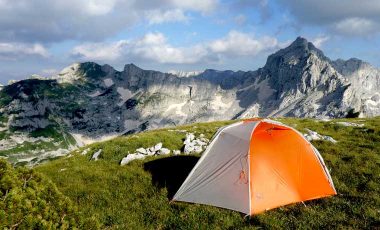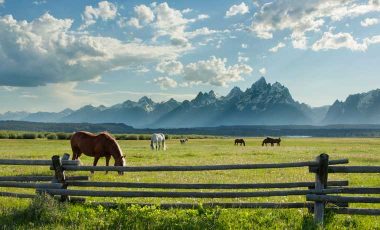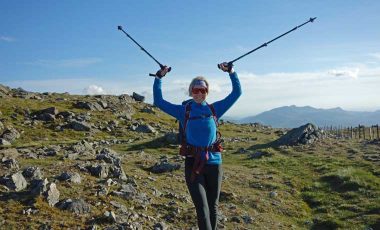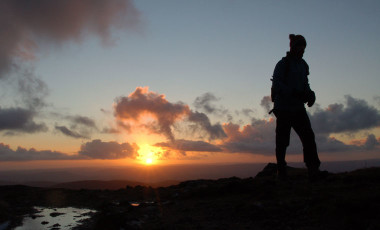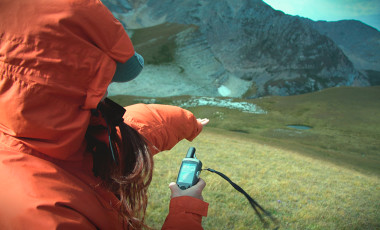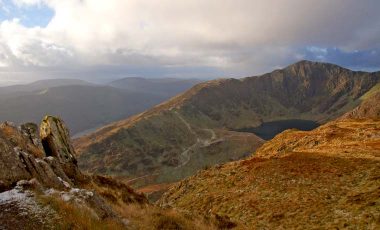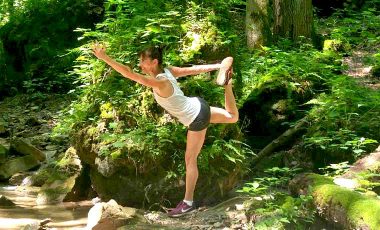Tucked away in the northern corner of Montenegro is Durmitor National Park. Part of the Dinaric Alps and covering 390km2, this UNESCO World Heritage Site is the largest protected area in Montenegro. And for good reason. It is stunning, remote, rugged, and largely untouched. In winter it attracts visitors to its modest ski slopes, accessed from Zabljak, the regions’ main town. But during the summer months an extensive network of hiking trails replace the snow-filled bowls and passes.
Durmitor National Park offers superb hiking and backpacking opportunities for everyone to enjoy. From short day hikes around the crystal clear lakes, to epic multi-day trips that cover high peaks and deep valleys.
We spent 5 days in the area in the middle of June. And with an unusually good window of weather opening up, we hit the trails for a three night trek through the mountains.
Hiking in Durmitor National Park
Day 1: Black Lake to Katun Lokvice
We didn’t set off from the entrance of the national park until around 7.30pm. On the plus side, this meant we had the trail totally to ourselves. But it also meant that the last 30 minutes of the route was done in almost darkness. The fireflies obliged, however, (as did the well marked route), and kept us perfectly on track, arriving at Katun Lokvice after just 2 hours of hiking. We pitched up alongside a few other tents and bedded down.
There is a natural spring in the bowl just to the west of the campsite where you can refill your water supplies.
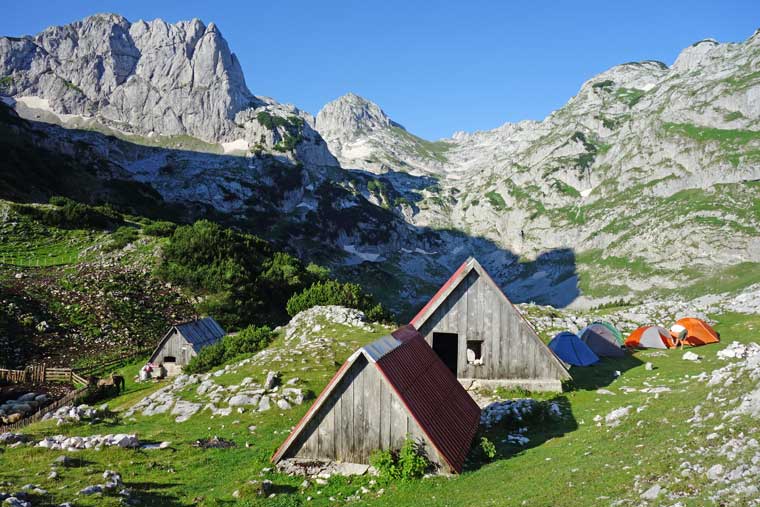
Day 2: Katun Lokvice to Zeleni Vir via Bobotov Kuk
Our first ‘proper’ day of hiking included the summit of Bobotov Kuk — the highest peak in Durmitor National Park. At 2,523 m (8,278 ft) it is also thought to be highest point in Montenegro. Our fellow campers set off with daypacks to tackle Bobotov Kuk before heading back to Katun Lokvice in one day. Many hikers attempt the summit from Black Lake or Sedlo (and back) in a day. We, however, wanted to get deep into the mountains. So we packed up everything and started the gentle climb through and around alpine bowls, meadows and boulder fields towards the peak.
Despite it being mid July, there were still small sections of trail covered by slushy ice and snow. But these were a breeze compared with the very steep scree section up to the saddle that preceded the final push to the summit. Extra care should be taken on this section as many large rocks can be easily dislodged — a death trap to climbers lower down on the slope.

We decided to ditch our packs at the saddle and enjoyed light-footed clambering to the top, where breathtaking views of the surrounding mountains greeted us. Our slow start meant that we enjoyed the summit to ourselves, only meeting other hikers on their way down.
Another hour of so of steep downhill took us to Zeleni Vir, a VERY chilly lake that allowed us to clean up and rehydrate.
Day 3: Zeleni Vir to Planinica
Another day of blue skies, a cool breeze and stunning views aplenty kept spirits high, despite a small meal packing error. Yes, I failed to pack one whole meal for two of us. Surprise Summit to Eat rice pudding to the rescue!
But the gorgeous and varied route, long stop off at Veliko Skrcko Jezero (lake), and the elation of reaching the peak of Planinica after a 2 hour constant uphill slog, certainly kept my mind off any calories I was lacking!
It’s fine to camp wherever you like in Durmitor National Park. That said, the rangers seemed to encourage us towards the allocated camping areas where you can pitch up for a small fee, or opt to stay in the mountain huts. But we chose to stay off the beaten track (as much as possible), and it really paid off.

The top of Planinica offered views even more spectacular than Bobotov Kuk. And to our relief, it also offered a perfect camping spot. Ordinarily, this highly exposed peak wouldn’t hold much appeal for would-be campers. But clear skies, breezeless air and faraway high clouds promised a night of tranquility that most hikers only dream of. It really was something you only see in magazines, captured after three days of sitting in a tent waiting for storms to pass. We, however, waltzed into Durmitor and got exactly what we wanted. So very grateful.
Day 4: Planinica to Black Lake
Our final day was mostly downhill. Some steep sections, some undulating, but each as beautiful as the last. The alpine meadows grew more colourful and lush the lower we got, until we reached the final section of woodland where tall pine trees replaced the vibrant display of flowers.
The two small lakes on the upper section of the route were almost dried up. And what water was available was polluted by cattle. We decided we were hydrated enough not to risk it, and rationed our water for the rest of the day. As it turns out, we were able to filter water only a couple of hours further on at Crepulj Poljana.

Although we met a lot of day hikers heading to the heights on Bobotov Kuk, we only came across a couple of multi-day backpackers. And for the majority of our time hiking in Durmitor National Park, it felt like we had the place to ourselves.
But it wasn’t just the seemingly untouched quietness that captured our hearts. The scenery was like nowhere else I’d ever been before. Dramatic, breathtaking, varied and ever-changing. At one turn a gentle, green valley is cut short by huge folding striations of gnarled ancient rock. The next, towering limestone pillars loom over deep bowls filled with rugged boulders. Then before your senses have the chance to process it all, you’ll walk right into rainbow-filled meadows, alive with the dance of insects and swirl of the breeze. An absolute must for visitors, even if hiking isn’t really your thing.
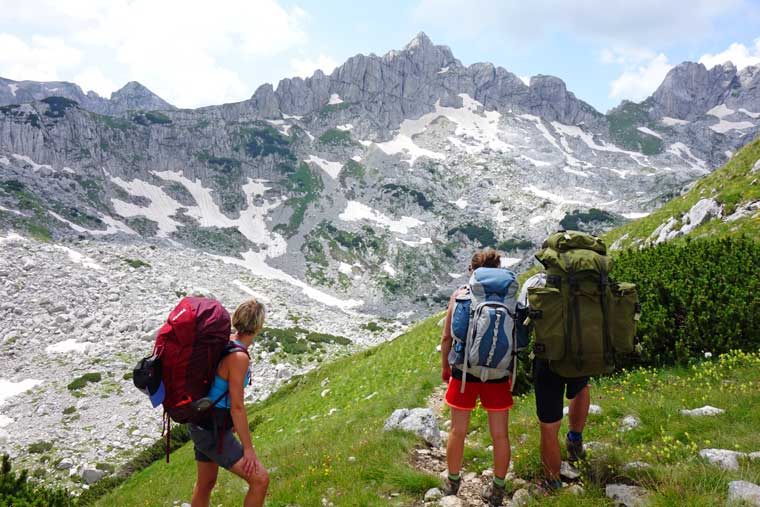
Top tips for hiking in Durmitor National Park
Weather
As with any mountain range, the weather is very changeable. Daytime temperatures during our July trip soared to the mid/high 20’s (ºC), whilst the cool nights dipped to well under 10ºC (and that was with little wind or rain). Storms come through the mountains quickly, so waterproof jackets and pants are a must.
Camping stove and fuel
Screw top gas canisters don’t really exist in Montenegro. The one place that does sell them, the Voli Supermarket in Zabljak, had sold out when we were there! We had a back-up multi-fuel stove, but also struggled to find any suitable fuel for this, other than petrol. You will find, however, plenty of pierceable gas canisters, as well as cheap stoves that they are compatible with.
Water supplies
There are very few natural sources of water in the mountains. A few streams and lakes, but you need to be smart about route planning to ensure you have plenty to drink and cook with. The rangers will help with this. On the final day we found a couple of pools that, during less dry times of the year, would have been ideal to filter from.
Food options
The local supermarket is really well stocked with everything you may need for your camping meals. You won’t get any fancy freeze-dried hiking meals, but there’s plenty of pasta, oats, nuts, dried meats and muesli bars.
Mapping
You can get a Durmitor National Park trail map at the tourist info in Zabljak, or at the entrance to the park. However, if you’re used to Ordnance Survey maps then using a backup mapping system is worth doing. We use downloaded ViewRanger Maps which also track your location via GPS.
National park access
You have to pay to enter the park, although no-one checked our ticket. You can sort this out at the entrance to the park.
Hiking in Durmitor National Park has most certainly been the highlight of my year. It’s a little more difficult to get to than the Alps, but when you get the place (almost) to yourself, it’s well worth the effort.
For those looking for some UK hiking, check out these routes in Snowdonia National Park.


